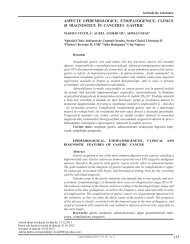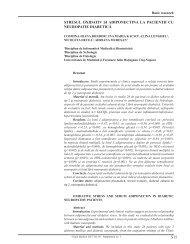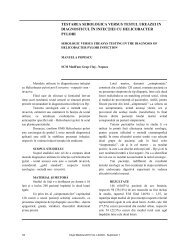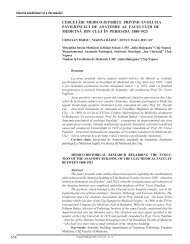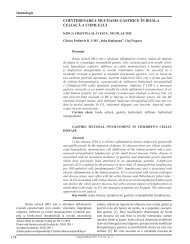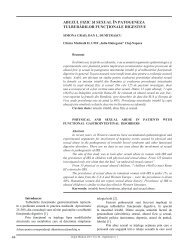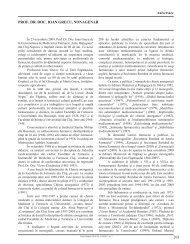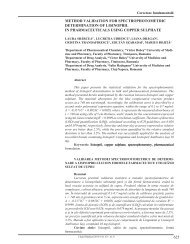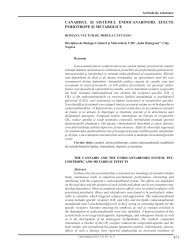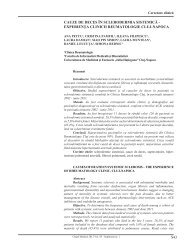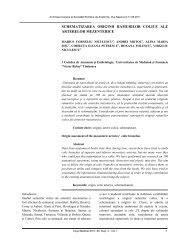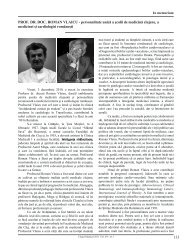You also want an ePaper? Increase the reach of your titles
YUMPU automatically turns print PDFs into web optimized ePapers that Google loves.
<strong>Clujul</strong> <strong>Medical</strong> 2006 vol. LXXX - nr. 1<br />
x 10 9 /l, and the microscopic investigation emphasized the increase of megakaryoblasts<br />
and micromegakaryocytes in the peripheral blood.<br />
At the family’s request the patient was discharged and died at home, so that<br />
necroptic investigations could not be performed.<br />
Evidence was recently provided about pathogenic factors and mechanisms<br />
relating megakaryoblastic leukemia to myelofibrosis. Actually the expression of the<br />
platelet derived growth factor (PDGF) and of the transforming growth factor beta 1<br />
(TGFβ1), which are both known to be involved in organ fibrosis, was found to be<br />
increased in blast cells of patients with transient myeloprolipherative disorder and acute<br />
megakaryoblastic leukemia (5,6). Noteworthy such growth factors may also be<br />
inappropriately released from monocytes (7).<br />
Another presumptive mechanism involved in organ fibrosis could be<br />
represented by an increased expression and activity of the intracellular factor XIII<br />
subunit A, a transglutaminase mediating crosslinking of fibrin polymers and of<br />
extracellular matrix proteins. Evidence was provided that F XIII subunit A is a reliable<br />
marker for acute myelomonocytic and megakaryoblastic leukemia (8), two pathologic<br />
conditions involved in the development of myelofibrosis (1,2,4). It is also known that by<br />
acting on extracellular matrix proteins such as fibronectin, vitronectin and collagen,<br />
FXIII subunit A contributes to wound healing and tissue repair (9). Interestingly,<br />
immunohistochemical investigations emphasized FXIIIA positivity in pulmonary<br />
fibrotic tissues, suggesting that this transglutaminase might have an important role in<br />
the development of organ fibrosis (10). It is worth mentioning that the activation<br />
mechanisms of FXIIIA subunit differ from those involved in the activation of<br />
circulating plasma factor XIII, in which the enzymatically active subunit A is assembled<br />
and stabilized by the liver secreted subunit B. Therefore plasma factor XIII A2B2<br />
zymogen becomes activated only by a thrombin-mediated limited proteolysis, this<br />
activation being accelerated by the presence of polymerized uncrosslinked fibrin and of<br />
calcium ions, while activation of cellular FXIII subunit A may undergo a slow<br />
spontaneous activation, which does not require fibrin polymers for its acceleration and<br />
occurs at lower concentration of Ca 2+ (11). In other words, the activation of FXIIIA<br />
subunit is regulated to a much lesser extent than plasma FXIII A2 B2 zymogen (11, 12).<br />
When not removed by fibrinolysis, persistent fibrin depositions are penetrated<br />
by fibroblasts and submitted to fibrous transformation. By catalysing the incorporation<br />
of α2 antiplasmin into the fibrin network, fibrin stabilizing factor XIII would limit<br />
fibrinolysis, thereby facilitating the persistence of fibrin depositions (13).<br />
The interrelations between factor XIII, reduced fibrinolysis and fibrosis are<br />
further promoted by the intervention of a fibroblast activation protein acting as an<br />
antiplasmin cleaving enzyme (APCE). It was demonstrated that by enzymatic cleaving<br />
of Methionin α2 antiplasmin (Met-α2AP), the resulting asparagine α2antiplasmin<br />
(Asnα2AP) becomes crosslink to fibrin about 13 times faster than Met-α2AP.<br />
Subsequently, the clot lysis rates are delayed and the progression of fibrosis is promoted<br />
(14).<br />
The above mentioned comments demonstrate that a thorough study of acute<br />
myelofibrosis may contribute to the elucidation of the pathogenic mechanisms involved<br />
in the fibrosis of other organs.<br />
References<br />
1. LEWIS SM, SZUR L: Malignant myelofibrosis. BrMed J 1963; 2: 472-476.<br />
2. ALLEGRA SR, BRODERICK PA: Acute aleukemic megakariocytic leukemia. Am<br />
J Clin Pathol 1971; 55: 197-204.<br />
3. LINMAN JW: Hematology. Physiologic, Pathophysiologic and clinical principles.<br />
McMillan Co Inc New York 1975, p 627.<br />
135



